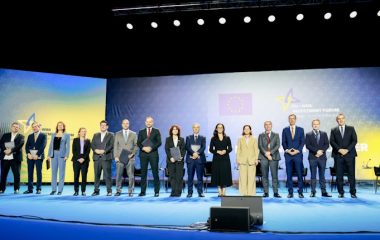
Photo: România Eficientă
The “Elie Radu” Energy Technology High School in Ploiești is Romania’s largest public school renovated under the EU’s nearly zero-energy building standards (NZEB). With the use of innovative energy efficient measures, the school’s energy consumption was reduced by 60 percent, and a large part of the consumed energy is produced onsite from solar photovoltaic and thermal panels.
A nearly zero-energy building (NZEB) is a building with a very high energy performance, while a large share of the nearly zero or very low amount of consumed energy is produced from renewable sources, onsite or nearby. High energy performance means its energy consumption is very low. The concept of NZEB is to jointly apply renewable energy and energy efficiency measures.
With the energy renovation, which started last summer, the school’s average yearly energy consumption was reduced by 60 percent. The school also produces electricity and heat with solar photovoltaic and thermal panels.
The building’s energy consumption was reduced by 60 percent
The building can meet its energy consumption needs, almost entirely during summer, from its own sources, according to the website of the România Eficientă project under which a EUR 1 million renovation was implemented.
România Eficientă said it was the first private investment of its kind and the largest renovation project applying NZEB standards in a public school.
The renovated building includes classrooms and a dormitory with a total of 1,500 square meters. It is used by about 250 pupils and 60 teaching staff members, while about 80 pupils are accommodated in the dormitory.
What was done?
The main energy rehabilitation works were carried on the outside and inside of the building. This is what was done:
- Insulation of the external walls, the terrace and the floors (over the unheated basement) with basalt mineral wool 15 cm thick and fireproof extruded polystyrene of 12 cm and 20 cm;
- Complete replacement of the existing doors and windows with energy-efficient aluminum;
- Replacement of the old fluorescent and incandescent lighting fixtures with LED lighting, with high energy efficiency and long lifecycle, and the installation of a smart remote control system;
- Installation of solar PV panels – 14 with a total installed capacity of 410 W;
- Installation of a domestic water heating system with 10 solar thermal panels and storage in boilers with a total capacity of 3,000 liters;
- Replacement of pipes and radiators in the whole building; replacement of all existing heating fixtures with new ones, and equipping them with thermostatic taps;
- Mounting of air filtration equipment with a heat recovery system and equipping the classrooms with air disinfection equipment;
- Installation of shading devices in the extremely sunny windows.
EU to switch from nearly zero-energy building to zero-emission building
The EU’s Energy Performance of Buildings Directive obligated EU countries to ensure by the end of 2020 that all new buildings were nearly zero-energy while all new public buildings had to be nearly zero-energy after December 31, 2018.
In December 2021, the commission proposed to revise the directive in order to move from the nearly zero-energy building standard to zero-emission building (ZEB). The ZEB requirement should apply as of 1 January 2030 to all new buildings, and as of January 1, 2027, to all new buildings occupied or owned by public authorities, the commission said earlier.
România Eficientă is a project implemented by Energy Policy Group (EPG) and OMV Petrom
România Eficientă is a private project of national scope carried out by Energy Policy Group (EPG) in partnership with OMV Petrom. Funds for the school renovation were secured by OMV, and the companies Signify and Electrica Group contributed with the equipment.
The project aims to support the achievement of Romania’s targets for 2030 regarding the reduction of carbon emissions and the increase in energy efficiency.









Be the first one to comment on this article.